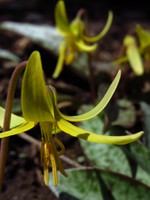We are all in transition. Something is always ending; something else sprouting.
For sure, some transitions are more painful, liberating, intentional, or dramatic than others. But, we can all point to things in our lives that are diminishing and to others that are taking root. Projects, relationships, health, life circumstances, the focus of our intentions and energies…. these all evolve. Nothing is fixed.

Walker and I hiked to Twin Falls on Sunday. A few days of unseasonably warm weather had gotten spring underway; a couple of very cold nights were a reminder not to be complacent. We ambled to the waterfalls with the dogs, enjoying the late March woods. A picnic lunch near the water invited a nap. On a whim, I climbed up to the base of one of the falls, and found fantastic ice formations from the spray and the previous night’s chill, still melting… the last vestiges of winter. Twenty feet away down the hill in the sun, the first trout lilies were already blooming. At the frothy edge of transition, ice and delicate lilies co-exist.
In transitions, if we are paying attention, we see signs of what is lingering and what is emergent. Transitions sometimes happen to us because of forces larger than us… like winter turning to spring, we are participants in these transitions, and it’s revealing to observe the signs all around us.
As we develop, we increasingly see the possibilities of becoming the agent of our own transitions. We choose to accelerate processes that might happen on their own anyway, but to which we can bring intentionality and purpose. Here, rather than signs simply appearing to mark and reveal transitions, we seek leverage points for accelerating them.
Paying attention to what is ending and what is beginning energizes the natural unfolding of transitions. For example:
- Declare an end to long-standing commitments that have run their course. Recently, I bowed out of an annual leadership program I had taught for 20 years. While it was fun and high quality and paid well, it was no longer the work that I was called to do, and consumed attention that I needed for other things.
- Yesses and Noes: From the myriad requests that come your way every day, bring awareness to your choices of what you say Yes to and what you say No to. Recognize that Yesses and Noes are the very currency with which you create your future.
- Honor what has been… it has made you into the only person you could be. Grieve what there is to grieve, appreciate what there is to appreciate. Recognizing and honoring what has been is essential to moving on.
-

We bring a future into being by prototyping new forms and possibilities Experiment. I’ve been involved in Otto Scharmer’s global community for profound social change for the past several months. We bring a future into being by prototyping new forms and possibilities. Whether fully formed or not, we engage others through these prototypes, and we learn more about the territory and how we can navigate it. We are in action towards a future.
- Be fallow. Take time to soak, change perspective, step outside the churn produced by your web of commitments. Pause. Moving at warp speed often leads to tightening and constriction, reducing the creativity and spaciousness required for new learning. The more pressure we are under, the more likely we are to revert to what we have done before. Take time and space, even when (especially when!) you’re too busy to do so.
- Create activators: bold commitments that establish new facts on the ground that require us to take new actions. Proposing marriage, signing a publishing contract, going public with a new offer, agreeing to a collaborative project… all of these catalyze and require new actions and thinking.
- Clarify the shape of the transition itself. We step back to a clearer view by articulating what is ending, and creating language around the future. We take the transition we are living inside of, and place it outside ourselves as an object that can be witnessed and observed. We begin to create movement and energy when we acknowledge what we are completing, and when we engage in conversations, visioning and learning that helps us perceive the territory that we are moving into.
Consider your frothy edge, where endings and beginnings are interspersed for you.
- What transition are you in?
- What is ending? What is being born?
- Which of these ways of attending to transitions speaks to you?
- What new actions might you take?
